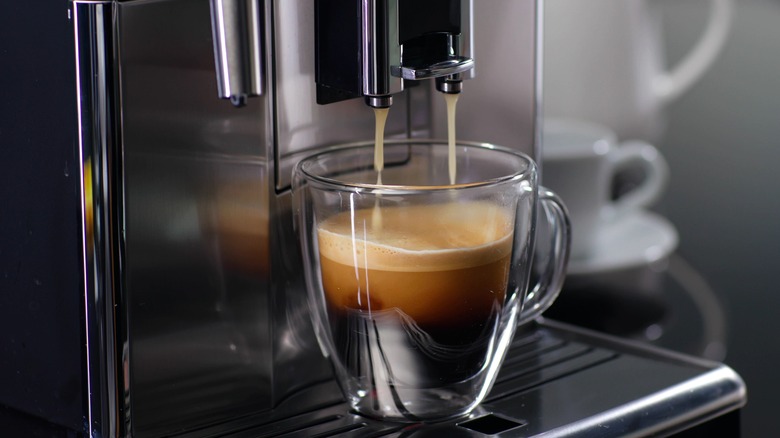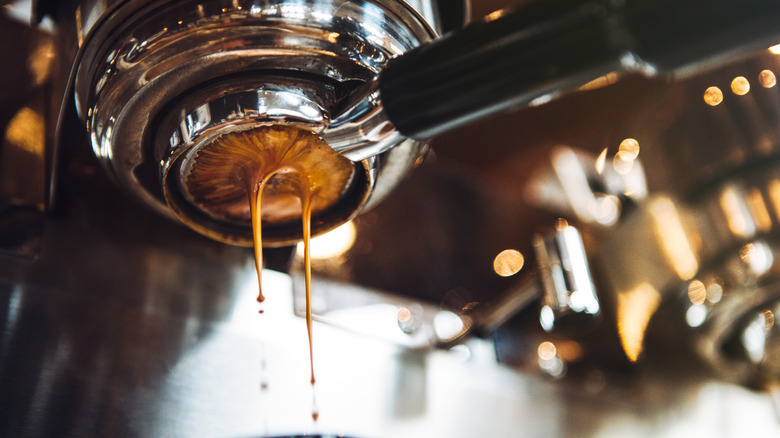How To Deep-Clean An Espresso Machine For Fresh-Tasting Coffee
Everybody needs their morning coffee, but by comparison, espresso is the way to not just start your day, but rocket boost it. Getting an espresso machine can feel like it'll change your life — but like any other coffee apparatus, that bad boy is going to need some occasional deep-cleaning. Ultimately it'll make your morning drinks taste much better because there won't be particles of espresso scunge in them — and you won't have to worry about drinking straight mold or bacteria.
That's the biggest issue here: Coffee makers and espresso machines are perfect incubators for mold and bacteria since they're warm, damp, and dark. If you don't clean your coffee appliances regularly, you could (and probably will) wind up drinking that stuff.
You can stay ahead of all of that, though, by simply cleaning the machine regularly. The steps may seem a bit complicated, but they're ultimately well worth it. You start pretty simply: Get the grounds out of the basket and wipe it down, then attach the portafilter (that bowl-like part with the long handle that holds the basket) to the machine and run water through it. But that's just the regular daily maintenance — the deep-cleaning starts after that.
The steps to deep-cleaning your espresso machine
There are several steps to this process, and if you're using your espresso machine at least every day, you should be doing this once a week. You can purchase espresso machine cleaner for this explicit purpose, and you're going to want some, because the first step is to turn that stuff into a cleaning fluid to scrub the portafilter, basket (the round thing with all the little holes where you put your grinds), and the group gasket (the round rubber guy on the part of the machine where the water comes out). Then thoroughly rinse them with warm water — because you don't want to wind up drinking cleaning solution.
Next, take off the screen from the group (the same part of the machine that has the group gasket), scrub both sides, and the part of the machine under where it was. Then take the blind basket (which looks just like the basket but without any holes), place it in the portafilter and secure that into the group. Following manufacturer's instructions, run the cleaning solution through the machine, then take the basket off and rinse it. From there, deep-clean the steam wand (it's the part that shoots the steam) with hot water and a good scrubbing. Remove the drip tray into which all the excess flows and wash it with dish soap in the sink. Then wipe down the outside of the machine. Boom, you're done.
Descale your espresso machine once a year
There's one last part of the cleaning process, though, and it's not even part of the regular deep-cleaning. If you're using water from the faucet, and your local tap water has a high mineral content (and let's be real, this is America, so it probably does), limescale is going to build up inside the machine. Once a year, you should descale the entire thing. There's a specific product called descaler, so get that first.
From there, this process is actually much simpler than the weekly deep-cleaning. You just dissolve or dilute the descaler in water and let that water sit in the machine for about 20 minutes. Then turn your machine on and run it through the system, making sure to run the solution through both the portafilter and the steam wand. Turn off the machine, let it sit for 20 minutes again, then run the rest of the solution through it. Then run clean water through it to rinse it out completely, and you're done.
This process may seem like a pain, but if you don't want to get sick — and if you don't want your coffee to taste bad — it's a good idea to do it. You'll thank yourself later.


